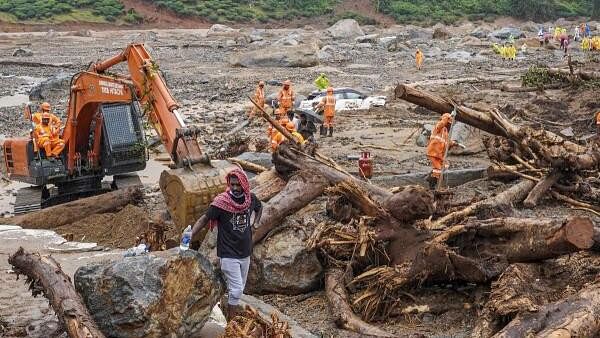
Search and rescue operations during a natural disaster.
Credit: PTI Photo
Agrahathinte Duranubhavam (Tragedy of Desire), a fictional story written by Laya A S in Wayanad, turned prophetic. In the story, two girls are warned by a talking bird to flee from their village as a great danger is approaching. Her father died in the Wayanad floods, and the story was published in the school’s digital magazine, Vellarm Kallukal.
Recently, more than 300 people are feared killed and many more are missing in floods in Himachal Pradesh, Uttarakhand, Delhi, and Rajasthan. Recent newspaper headlines give a picture: ‘Wayanad toll mounts to 300, 220 still missing’, ‘4 drown, 6 electrocuted as 13 die in Delhi NCR rain’, ‘La Niña spurred rain may trigger landslides in September’, ‘Woman and son drown in drain during weekly market’, and many more.
Disasters are the new norm
The Intergovernmental Panel on Climate Change (IPCC)’s VI report has forewarned about the recurrence of climate-induced disasters in the subcontinent. The report highlights the very high vulnerability of the mountains, especially the Himalayas, and coastal India. According to the report, the frequency of extreme weather events will be much higher than in the past due to the anthropogenic nature of climate change. There will be high precipitation in a shorter period, increasing water runoff and triggering many disasters in both urban and rural India.
Floods and fertility are linked
Flash floods are not new to mountains; they have been occurring for a very long time. However, the frequency of floods has increased recently. Floods from the mountains contribute to the fertility of the plains. The rich alluvial soils of the Gangetic basin are a result of such floods in the past. Flash floods in the mountains should be considered an essential feature of the larger ecosystem.
Greater loss to lives and assets due to disruptive planning
If floods are natural, why is there a greater loss of lives and assets now? This question needs to be answered from a developmental perspective. Let us take two examples: the developmental trajectory in the Himalayas and mountains, and the urban development models across India.
Urban models leading to enhanced vulnerability
The current model of urbanisation and urban growth is guided by the 4-5-decade-old notion of ‘cities being engines of growth’. Once this becomes a guiding principle, questions like what kind of growth, who will be the prime movers of growth, and its relation to urban ecology and environment cannot be brushed aside. However, growth in cities is guided by the principles of economic growth, with land playing an important role.
Projects in the last three decades, whether on mobility, housing, providing civic amenities, etc., are guided by leveraging the surplus generation capacities of the cities. For example, the construction of flyovers, widening of roads, smart city projects, and other infrastructure projects are pushed forward without considering crucial aspects of ecology, and urban commons like open spaces, water bodies, pedestrian paths, playgrounds, parks, etc. The recent floods in Delhi, despite high precipitation, resulted in destruction due to clogged drains or drains being usurped for constructing flyovers, metro rails, and open spaces being encroached upon. A recent study pointed out that cities that had hardly experienced flooding were badly hit by rains because of smart city mission projects.
Mountains need a different developmental approach
In the economic growth paradigm, even mountains are seen from the perspective of commoditising the natural environment. Let us take the example of hydropower projects in the Himalayas. Scientists pushed for suggesting run-of-the-river dam technology and small and micro hydro projects, claiming that such a shift would have less impact on the environment. However, the recent flash floods have shown that the riverbeds, turned into dumping sites as the river was channelled through the mountains, became extremely vulnerable. The small and micro hydro projects were devastated by rains on mountain tops, leading to massive destruction in the Rampur and Kullu regions of Himachal Pradesh.
What should be done?
Thomson M, an anthropologist, pointed out in the late 1970s that once the sequestration levels in the Himalayas are high, even a 100% canopy of forests cannot protect the hill from sliding if it is vulnerable. What the Union and state governments must do immediately is: to complete mapping of the mountains and create a vulnerability atlas, in vulnerable zones a 'no means no' dictum for habitat should be enforced, revisiting the unbridled and rampant objectification of the mountains for four-lane highways and hydropower projects, strengthening early warning systems along with capacity-building of the communities and district administrations for evacuation response, conduct geological and hydrological mapping of the town, and this should lay the developmental trajectory for the cities, empower people, communities, and urban local bodies in zoning exercises, and, localise design based on climate risk information.
(Tikender Singh Panwar is former deputy mayor, Shimla, and member, Kerala Urban Commission.)
Disclaimer: The views expressed above are the author's own. They do not necessarily reflect the views of DH.